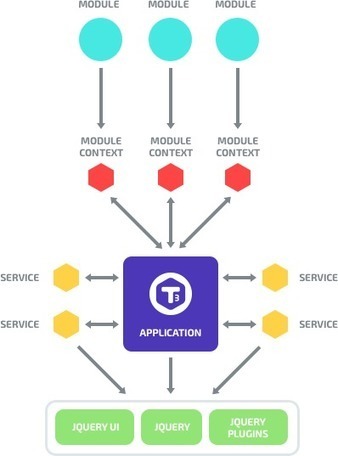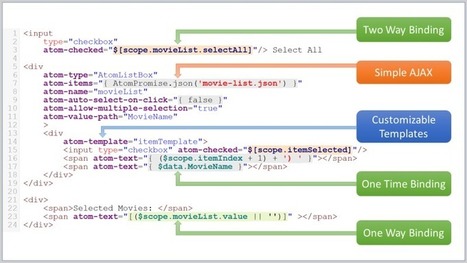80 million monthly visitors, loads up to 10,000 requests per second, and 15 million items, adding more than one million new items each month is what Walmart.com’s scale is all about. With an e-commerce business that holds the number two online retailer spot in the U.S., we needed not just to scale Walmart.com, but to really leverage the talent and creativity of our engineering base.
Get Started for FREE
Sign up with Facebook Sign up with X
I don't have a Facebook or a X account



 Your new post is loading... Your new post is loading...
 Your new post is loading... Your new post is loading...
Current selected tag: 'Frameworks'. Clear
No comment yet.
Sign up to comment
From
sam
SAM is a new reactive/functional pattern that simplifies Front-End architectures by clearly separating the business logic from the view and, in particular, strictly decoupling back-end APIs from the Front-End. SAM is technology independent and as such can be used to build Web Apps or Native Apps. It is also protocol independent and can be implemented over HTTP, WebSockets... SAM is unapologetically driven by simplicity and challenges the complexity of frameworks like Google's Angular or Facebook's React+JSX+Flux/Redux+Saga+Thunk+GraphQL+Relay. One of SAM's key goals is to enable everyone to build beautiful and engaging HTML5/CSS3/JavaScript Web Apps while retaining what makes React.js so unique:
JavaScript Frameworks' longevity is an often overlooked yet critical ingredient in project success. Every six months, a hot new framework hits the mainstream, and our community explodes with excitement. Don’t believe the hype. Framework longevity is a critical ingredient in project success. Most technology decision makers use metrics like community size, popularity, and big company support to justify their choice of framework, but these factors actually don’t predict longevity. FOAM is composed of tools to help you quickly write an app that loads and runs fast, on desktop and mobile. Our main goal is to do as much as possible with each chunk of code. The fastest, most secure, and least buggy code in your app is the code that isn’t there. FOAM is a meta-programming framework. It is very declarative and reactive, because that’s a very high-level way of expressing how the app should work. From simple user interfaces to complex single-page applications using faster, server-side rendered and easy to learn framework Model-View-Controller, Model-View-Collection, Model-View-ViewModel, Model-View-Whatever, Hierarchical Model-View-Controller or nothing at all - jsblocks got you covered. A Model-View-Collection layer stands on top of the main DOM syncing core. The MVC layer is extremely powerful and enables easy creation of complex applications. The MVC layer is also modular so you could remove it if you don't need the extra functionality and make your code base lighter.
From
t3js
T3 is different than most JavaScript frameworks. It's meant to be a small piece of an overall architecture that allows you to build scalable client-side code. A T3 application is managed by theApplication object, whose primary job is to manage modules, services, and behaviors. It's the combination of these three types of objects that allow you to build a scalable JavaScript front-end. T3's design enforces best practices such as loose coupling by limiting how certain components can communicate with each other. Modules cannot interact directly with other modules but may communicate with them through an event bus. Modules may use services directly, but may only reference behaviors in a declarative way. These restrictions ensure that the various pieces remain loosely-coupled to make dependency management easy and maintenance self-contained. The loosely-coupled nature of T3 components means that creating tests is easy. Dependencies are injected into each component, making it trivial to substitute a mock object in place of real ones.
Jan Hesse's insight:
From
platypi
The sample app is 5 screens and fully functional with security, navigation drawer, and backend service communication. Upon completion, the app enables the user to login, make a selection of a t-shirt and place an order.
From
github
Mesh is a universal interface for communicating with data sources whether it's your API, mongodb, pubnub, webrtc, socket.io, redis, or local storage. Easily build sophisticated features such as offline-mode, realtime data, rollbacks, and more with little effort. Mesh is entirely customizable, and doesn't make assumptions about how a data source works. You can easily build your own API adapter that's interoperable with all the other mesh plugins. Matreshka is a framework for massive and endlessly extending single page applications (within the Universe, of course), written in JavaScript. It allows you to build the program architecture so that neither your team nor you can get confused in plentiful entities, logic described in HTML files, numerous restrictions of other frameworks and incomprehensible abstractions. Two-way data binding is implemented by bindNode method only and it does not require to change HTML, adding weird {{syntactic.constructions}}. Having set a few rules, a programmer can continue to work with data and forget about the state of the visible part of the application. The Model handles data and business logic Allowing for clear separation between the presentation (UI) and application logic Enabling easier maintainability and clarity.
From
github
"best perceived speed, the greatest code freedom, and the strongest search engine optimization" Brisket is a framework for building single page web apps using isomorphic JavaScript. A Brisket app is both a traditional web site AND a single page web application at the same time. Brisket provides the tools that you need to spend your time focusing on your application's logic rather than on "what environment is my code running in?".
From
github
mvstar-compare - A brief comparison of a few MV* front end frameworks Scope Documentation - How well do they document their API? Class creation, custom events, and data methods. That's all it does. Even a lightweight framework like Backbonehas more than 75 methods, Stapes has just 20. |
This post is a tutorial for writing a next-gen JavaScript Framework & solving problems regarding extendibility, dependency injection and private variables.
In this chapter, I am going to explain how NX is structured, and how I solved its use case specific difficulties regarding extendibility, dependency injection and private variables. The series includes the following chapters.
Vue.js makes everything easy. Creating seemingly complex applications becomes super simple and is something that can be done in much less time than previously. We will demonstrate this by creating a Github file explorer that will allow us to explore files in public Github repos. All the code for this post can be found on […] Earlier this year CODE Magazine published an article I authored encouraging the use of MicroJS libraries instead of large frameworks. One question I attempted to answer was where to find libraries, which of course there are many possible sources. Another question I am often asked is how do I choose a library? This is important because choosing a bad library can lead to bad consequences. How Do I Evalutate JavaScript Libraries I have no absolute rules on choosing a library, but I do have some evaluations I make before picking a library. Today I want to review some of the criteria I use and some simple examples of how they apply to choosing the best JavaScript libraries for your application.
From
github
AtomsPreCompiler compiles atoms markup into valid HTML5 by breaking up inline expressions into generated JavaScript. This pre-compiled document runs in strict mode without using eval without compromising speed.
Jan Hesse's insight:
Node devs tend to be minimalists, DIY’ers, Lego™ artists, if you will. We want a nice set of tools and pieces at our disposal that we can compose into whatever creation we imagine. If you’ve bought into Node’s small module paradigm, stuff like Ember, Angular, and even jQuery can feel a bit like excessively large Duplo™ blocks. To be clear, this doesn’t make them bad. I’m glad they exist. Clearly, they empower scores of developers to create some great things on the frontend. Of course we think Ampersand modules are a great match for building frontends for our Node applications. But for Ampersand we use the term “framework” very loosely. As demonstrated by how people are using it, it’s really is just a loosely coupled set of tools. In the end, the only constant in our field is change. We simply cannot, in good conscience, assert that any single toolset (even our own) is the only valid approach. It’s just not how we think development should work.
From
medium
How and why I was driven into the warm embrace of my very own web stack Once I started going down this path, I tried to come up with what the ideal web app bootstrapping framework might actually look like. I took my codebase and literally started moving files around, trying to come up with a sane way of organizing everything that didn’t feel like a bunch of duct tape and bubble gum. Here are the guidelines I came up with during this process...
Jan Hesse's insight:
From
github
Paperclip is a reactive template engine that compiles HTML to DOM. All optimizations happen at compile time, so you can expect snappy and efficient user interfaces across desktop, and mobile devices. A tiny foundation for creating reactive components with interpolation, data-binding, and plugins. It's simple, flexible and easy to extend. It aims to have a similar API to Reactive, but allow composition of views, like React. The major difference for other view libraries is that there are no globals used at all. Each view has its own set of bindings and plugins. This makes composition of views really easy.
From
twee
TWEE.IO | MVC framework for Node.js and io.js based on Express.js with sockets and extensions support A client-server web framework built on Node.js that allows front-end developers to easily create a 100% SEO compliant, component MVC structured web application with an optimized first page load.
From
acidjs
ACIDjs is a modern Javascript framework with a focus on current & future APIs. ACIDjs is specifically designed to scale for applications as they grow.
From
www
neft.io is a JavaScript Framework that has been made for easier and faster developing applications and 2d games. It runs in a browser, a server and truly natively on iOS, Android, Windows Phone, OS X, Linux, Windows and more (60 FPSs). This website has been written in the neft.io. JavaScript interpreters are really fast, but we recognized that DOM and CSS are the problem. We wrote light and really fast virtual-DOM. For you, nothing changed here: your HTML document is still valid. In neft you'll use CSS-like syntax. It's super fast in a browser (we use hardware accelerated transformations) and extremely responsive on a mobile. As we said, we take native serious. We don't wrap your application into a browser using e.g. the PhoneGap, because we don't use CSS. No extra modifications are required for the native apps. We support iOS, Android, Windows Phone, BlackBerry 10, Windows, Linux, OS X, Sailfish OS and more by the Qt technology. |



























